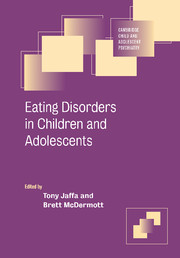Book contents
- Frontmatter
- Contents
- List of Contributors
- Part I Introduction
- Part II Scientific underpinnings
- 2 Regulation of food intake and body weight
- 3 The development of children's shape and weight concerns
- 4 Relation of dieting to eating pathology
- 5 Physical and cognitive changes associated with puberty
- 6 Genetic influences in the development of eating disorders
- 7 Epidemiology of eating disorders
- 8 Neuroimaging
- Part III Abnormal states
- Part IV Evidence-based care
- Part V Public health perspectives
- Index
- References
5 - Physical and cognitive changes associated with puberty
from Part II - Scientific underpinnings
Published online by Cambridge University Press: 02 December 2009
- Frontmatter
- Contents
- List of Contributors
- Part I Introduction
- Part II Scientific underpinnings
- 2 Regulation of food intake and body weight
- 3 The development of children's shape and weight concerns
- 4 Relation of dieting to eating pathology
- 5 Physical and cognitive changes associated with puberty
- 6 Genetic influences in the development of eating disorders
- 7 Epidemiology of eating disorders
- 8 Neuroimaging
- Part III Abnormal states
- Part IV Evidence-based care
- Part V Public health perspectives
- Index
- References
Summary
Puberty is perhaps the most important of life transitions. The changes that occur as a result of puberty are both dramatic and universal. It is a process of rapid and simultaneous transformation in biological, social and psychological dimensions of development. Although it may appear that puberty is a discreet event that punctuates the shift from childhood to adulthood, in reality it is a part in a series of events that begins at the time of conception. Our goal in this chapter is to discuss the physical and cognitive changes characteristic of pubertal maturation. New evidence suggests that there are sex differences regarding the biology of puberty that were not previously understood, and this too will be reviewed (Fechner, 2003).
Fetal life
Physical maturation and reproductive functioning are controlled by the endocrine system that operates first through the hypothalamic–pituitary–adrenal axis (HPA system) and then through the hypothalamic–pituitary–gonadal (HPG) axis (Grumbach & Styne, 1998). During the prenatal period, it is the exposure to androgens that organizes the reproductive system (Reiter & Grumbach, 1982). The hypothalamic–gonadotropin releasing hormone (GnRH) pulse generator is initially active during fetal life and early infancy, but is then suppressed during childhood (see Fig. 5.1).
Differences in male and female patterns of gonadotropin secretion have been described during fetal life (Beck-Peccoz et al., 1991). Luteinizing hormone (LH) and follicle-stimulating hormone (FSH) are produced by the gonadotropic cells of the pituitary gland and stimulate the ovaries and testes to secrete oestrogen and testosterone, respectively.
- Type
- Chapter
- Information
- Eating Disorders in Children and Adolescents , pp. 57 - 69Publisher: Cambridge University PressPrint publication year: 2006

